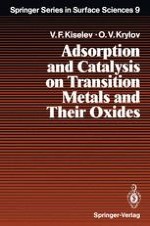This book deals with adsorption and catalysis on the surface of transition elements and their compounds, many of which are in teresting because of their particular electronic structure. The authors have worked through a vast body of experimental evi dence on the structure and properties of surfaces of transition metals and relevant oxides. Consideration is given mostly to simple (as opposed to mixed) oxides of transition elements, to common metals and to the adsorption of simple gases. A great deal of attention is paid to the nature of active surface sites responsible for chemisorption and catalytic transformations. The description relies mainly on the simplified ligand-field theory, which, however, proves quite satisfactory for predicting the adsorptive and catalytic activity of species. In many cases simple systems were explored with the aid of novel techniques, and it is only for such systems that the mechanism of the ele mentary act of adsorption and catalysis can be given adequate treatment. The present monograph has emerged from our earlier work in Russian, which appeared in the Khimiya Publishing House (Mos cow) in 1981. This English edition has, however, been revised completely to broaden its scope and to include more recent a chievements. For fruitful discussions the authors are grateful to A.A.
